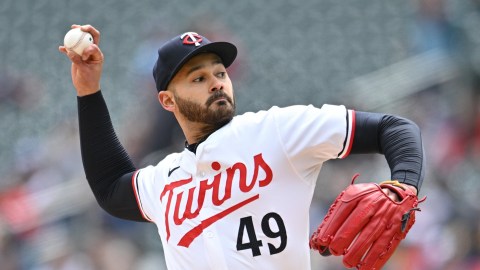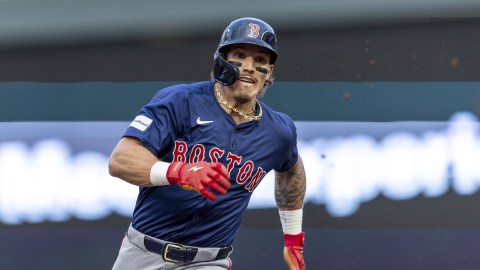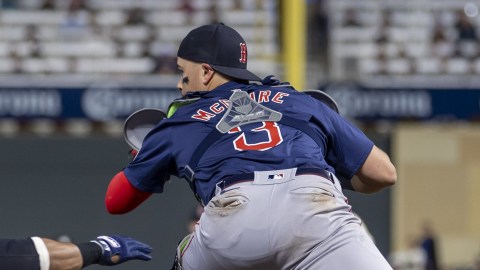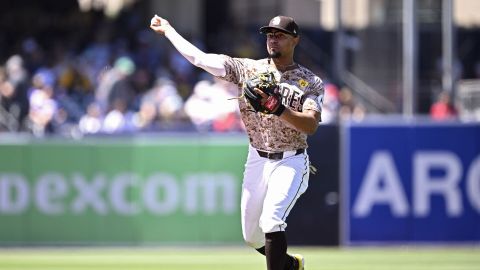The Red Sox’ minor league system has produced some of the best young players in baseball over the past five seasons, from former MVP and All-Star Dustin Pedroia to key role players such as Daniel Bard.
Boston’s farm consistently ranks as one of the best in baseball, and 2010 is no different, as the next wave of future Red Sox get ready to make an impact on the major league club.
Below are the five Red Sox prospects who have made the biggest leaps forward or taken the biggest steps backward in their development. These players still have nearly a third of a season left to continue their successes or struggles, but this list should give you a good idea of where the Red Sox’ prospects will rank headed into next season.
Most Improvement
1. Ryan Kalish, outfielder
The Red Sox named Kalish their minor league offensive player of the year last season, and the young outfielder has continued his success in 2010. In 252 at-bats between Double and Triple-A, Kalish is hitting .302 with 10 home runs, 40 RBIs and a .399 OBP. He has stolen 23 bases in 25 attempts. Kalish also is showing improvement as the season progresses, and is currently hitting .370 in July. A future 20 home run/20 stolen base threat, Kalish should see time in the majors this season, and has likely surpassed fellow prospect Josh Reddick on the Red Sox’ outfield depth chart. If Kalish adds a little more power to his game, he could become Boston’s right fielder of the future when J.D. Drew’s contract expires after the 2011 season.
2. Felix Doubront, starting pitcher
The Red Sox have taken an aggressive developmental approach with Doubront ever since he signed with them as a 17-year-old out of Venezuela in 2004. Despite constantly facing older competition, Doubront has made steady progress in the minors nearly every season, allowing him to make his MLB debut in June at the age of 22. Doubront earned his spot on Boston’s staff by improving his numbers across the board from his 2009 campaign, posting a 7-2 record, 2.45 ERA and 8.0 K/9 ratio between Portland and Pawtucket. Doubront could use another half-season in the minors to refine his command and work on his curveball, but he should become a reliable left-handed No. 4 starter in the Joe Saunders mold.
3. Will Middlebrooks, third baseman
One of the most athletic players in the Red Sox’ system, Middlebrooks is having a breakout year in high Single-A Salem. After putting up pedestrian numbers in his first two professional seasons, Middlebrooks is hitting .295 with eight home runs, 53 RBIs, 24 doubles and a .354 OBP in 2010. Middlebrooks has all the tools of a prototypical third baseman, sporting plus raw power and an incredibly strong arm, and is agile enough that the Red Sox initially considered playing him at shortstop. Middlebrooks’ .390 BABIP suggests that his average is a little inflated, but his lefty/righty splits are nearly equal, and he’s hitting .356 with a .610 slugging percentage in July. Middlebrooks is on pace for a late-season promotion to Double-A, and should head into 2011 as one of the Sox’ top 10 prospects.
4. Drake Britton, starting pitcher
Britton was only a few months into his professional career in 2008 when he blew out his elbow, necessitating Tommy John surgery that September. His recovery limited him to just 12 innings pitched in rookie ball last year, in what was basically a lost season for the young lefty. Britton has rebounded in a big way in 2010, however, and has come back from surgery to throw harder than he did before. Britton is currently posting a 2.82 ERA, .224 batting average against and 8.7 K/9 ratio in Single-A Greensville. He is on pace to throw twice as many innings pitched as he had in his entire career before 2010. He’s far from a finished product and may eventually end up in the bullpen, but lefties who can throw 97 mph are hard to find, and Britton could start 2011 in Portland.
5. Ryan Lavarnway, catcher
It’s been a rough year for most of the Red Sox’ minor league catchers, but Lavarnway has torn the cover off the ball since day one. Lavarnway led all Red Sox minor leaguers with 21 home runs last season, and hit .285 with 84 RBIs and 36 doubles in what was arguably the best offensive season of any Boston prospect. He followed up his terrific 2009 campaign by hitting .289 with 14 home runs and 63 RBIs in high Single-A Salem this season, and was promoted to Double-A just over a week ago. Lavarnway has never been viewed as much of a prospect — Baseball America didn’t place him in the Red Sox’ top 30 prospects before the season — but he’s forcing scouts everywhere to reevaluate him. There are serious concerns about Lavarnway’s ability to stay behind the plate, but if he can become even an average defender, his plus power should eventually carry him to the majors.
Biggest Regression
1. Junichi Tazawa, starting pitcher
When the Red Sox signed Tazawa out of Japan in 2009, they envisioned him becoming a middle-of-the-rotation innings-eater in relatively short order. Tazawa came much as advertised, dominating Double-A and Triple-A, and even making four starts for the big league club in his first professional season. He looked poised to make a big impact on the Red Sox this season, but injured his elbow in the early spring and required Tommy John surgery in April. Tazawa will miss all of 2010, and likely will need at least half of 2011 to regain his command, but his long-term ceiling remains mostly unchanged. The fact that Tazawa would be injured this season seems especially cruel, however, as the Sox have been plagued by injuries to their rotation and ineffectiveness in their bullpen.
2. Michael Bowden, pitcher
At first glance, Bowden appears to be putting up pretty solid stats this season. In 92 innings pitched in Triple-A, Bowden was sporting a 6-3 record, 3.52 ERA and 1.04 WHIP. He lowered his walk rate from last season as well. As encouraging as those numbers may be, Bowden’s secondary stats show some significant regression. Bowden’s fielding independent pitching sits at 4.57, he’s only inducing a 22.1 percent ground-ball percentage, and he’s allowing a HR/9 ratio of 1.16. Those numbers suggest that Bowden has been very hittable this season, and likely facilitated his move to the bullpen earlier this month. Bowden can still be a huge asset to the Red Sox, and can serve in much the same role as Justin Masterson did before he was traded to the Indians, but his upside has diminished considerably.
3. Josh Reddick, outfielder
Back in April, it would have been difficult to predict the kind of struggles Reddick would encounter this season. After hitting .390 in spring training — the highest average for any Red Sox with at least 50 at-bats — Reddick seemed ready to take the next step toward becoming a fixture in Boston’s outfield. Reddick has been consistently awful all year, however, and currently owns a .218-8-37 batting line through 293 at-bats in Triple-A. Reddick is competing with Ryan Kalish to be the Red Sox’ right fielder of the future, and while Kalish has a better eye and more speed, Reddick has more natural power and a much better arm. Reddick’s career OBP is just .328, however, and he needs to start being more selective at the plate if he wants be more than a career fourth outfielder.
4. Casey Kelly, starting pitcher
Still just 20 years old, Kelly remains fully capable of being a dominating No. 2 major league starter and continues to be one of the best pitching prospects in the minors. There is no denying that Kelly has seen his share of struggles in Double-A this season, though, and his major league ETA may be a little farther in the future than many predicted. After completely dominating class-A hitters last season, Kelly is sporting a 4.85 ERA and 1.59 WHIP in 2010, and is walking more than twice as many batters as he did in 2009. On the bright side, advanced statistics dictate that his ERA should be half a run lower, and he’s increased his K/9 rate as well. Kelly is still on pace to reach the majors by the time he’s 22 or 23, but he’ll likely have to spend at least half of 2011 repeating Double-A.
5. Tim Federowicz, catcher
It’s normal for catchers to progress more slowly than other position players, but Federowicz is testing the limits of what’s acceptable even for a backstop. Baseball America tabbed Federowicz as the Red Sox’ "best hope for a homegrown catcher of the future" before the season, but he’s done little to live up to that billing in 2010. Through 322 at-bats in high Single-A Salem, Federowicz is hitting just .261 with four home runs, 49 RBIs and a .337 OBP, and has regressed in nearly every major offensive category from a year ago. Federowicz has always been known more for his defense, and has thrown out 35 percent of opposing runners while allowing just four passed balls this season. His questionable bat significantly limits his ceiling, however, and it’s beginning to look more like his future is as a major league backup.
Note: Ryan Westmoreland, the Red Sox’ top-rated prospect before the season, has been omitted from this list after undergoing successful brain surgery in March. Ryan’s baseball future is unclear, but we wish him a full and speedy recovery from his life-threatening condition.



